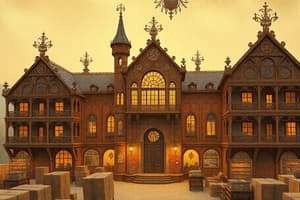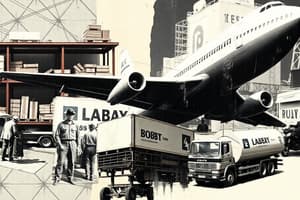Podcast
Questions and Answers
is the term used to describe the method and means by which a product or a group of products are physically transferred, or distributed, from their point of production to the point at which they are made available to the final customer.
is the term used to describe the method and means by which a product or a group of products are physically transferred, or distributed, from their point of production to the point at which they are made available to the final customer.
Physical distribution
the end point is, generally, a retail outlet but, increasingly, it may also be the customer's house, because some channels bypass the shop and go
direct to the consumer
•for some products, such as music, films, etc., the physical product can be transferred via the internet.
the end point is, generally, a retail outlet but, increasingly, it may also be the customer's house, because some channels bypass the shop and go direct to the consumer •for some products, such as music, films, etc., the physical product can be transferred via the internet.
FOR CONSUMER PRODUCTS
• the physical channel is likely to be from a manufacturer/supplier to an end point, which is likely to be a factory.
• the physical channel is likely to be from a manufacturer/supplier to an end point, which is likely to be a factory.
FOR INDUSTRIAL PRODUCTS
WHAT IS A DISTRIBUTION CHANNEL?
WHAT IS A DISTRIBUTION CHANNEL?
IMPORTANCE OF DISTRIBUTION CYCLE
IMPORTANCE OF DISTRIBUTION CYCLE
FUNCTIONS OF DISTRIBUTION
CHANNELS
FUNCTIONS OF DISTRIBUTION CHANNELS
FUNCTIONS OF DISTRIBUTION
CHANNELS
FUNCTIONS OF DISTRIBUTION CHANNELS
FUNCTIONS OF DISTRIBUTION
CHANNELS
FUNCTIONS OF DISTRIBUTION CHANNELS
TYPES OF DISTRIBUTION
CHANNELS
TYPES OF DISTRIBUTION CHANNELS
• one of the oldest forms of selling products.
• It doesn't involve the inclusion of an intermediary and the manufacturer gets in direct contact with the customer at the point of sale.
• Some examples of direct channels are peddling, brand retail stores, taking orders on the company's website, etc.
a an de hae tnget tdiane e gaugip hcaly Etcamentad For cneipie, Ptct.
• one of the oldest forms of selling products. • It doesn't involve the inclusion of an intermediary and the manufacturer gets in direct contact with the customer at the point of sale. • Some examples of direct channels are peddling, brand retail stores, taking orders on the company's website, etc. a an de hae tnget tdiane e gaugip hcaly Etcamentad For cneipie, Ptct.
When a manufacturer involves a middleman/intermediary to sell its product to the end customer,
• Indirect channels can be classified into three types.
When a manufacturer involves a middleman/intermediary to sell its product to the end customer, • Indirect channels can be classified into three types.
Retailers buy the product from the manufacturer and then sell it to the customers.
dealing in shopping goods like clothes, shoes, furniture, toys, etc.
Retailers buy the product from the manufacturer and then sell it to the customers. dealing in shopping goods like clothes, shoes, furniture, toys, etc.
Wholesalers buy the bulk from the manufacturers, breaks it down into small packages and sells them to retailers who eventually sell it to the end customers.
• Goods which are durable, standardized and somewhat inexpensive and whose target audience isn't limited to a confined area use two-level channel of distribution.
Wholesalers buy the bulk from the manufacturers, breaks it down into small packages and sells them to retailers who eventually sell it to the end customers. • Goods which are durable, standardized and somewhat inexpensive and whose target audience isn't limited to a confined area use two-level channel of distribution.
Involves an agent besides the wholesaler and retailer who assists in selling goods. These agents come handy when goods need to move quickly into the market soon after the order is placed.
spread all over the country and the demand of the product is very high.
Involves an agent besides the wholesaler and retailer who assists in selling goods. These agents come handy when goods need to move quickly into the market soon after the order is placed. spread all over the country and the demand of the product is very high.
Categories of agents
Categories of agents
When a manufacturer uses more than one marketing channel simultaneously to reach the end user, he is said to be using the dual distribution strategy.
• They may open their own showrooms to sell the product directly while at the same time use internet marketplaces and other retailers to attract more customers.
• A perfect example of goods sold through dual distribution is smartphones.
When a manufacturer uses more than one marketing channel simultaneously to reach the end user, he is said to be using the dual distribution strategy. • They may open their own showrooms to sell the product directly while at the same time use internet marketplaces and other retailers to attract more customers. • A perfect example of goods sold through dual distribution is smartphones.
DISTRIBUTION CHANNELS FOR
SERVICES
DISTRIBUTION CHANNELS FOR SERVICES
Flashcards are hidden until you start studying



